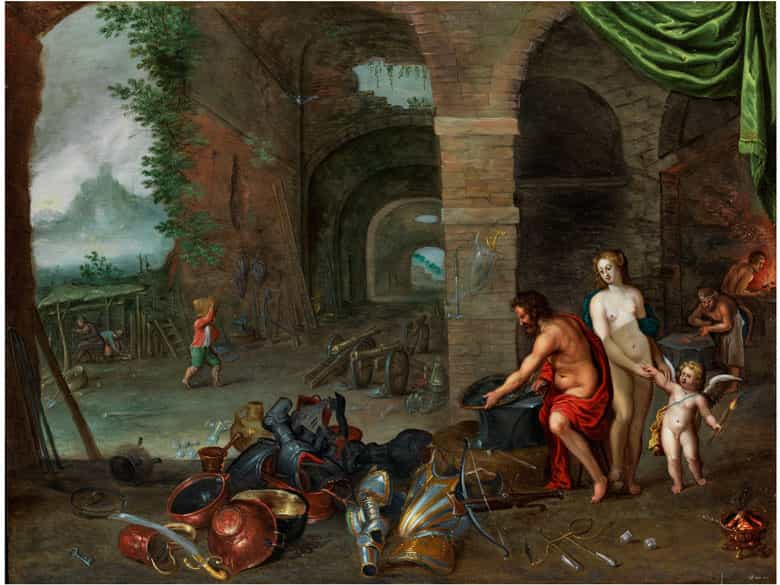Auction 16th - 18th century paintings
» reset
Your personal art agent

You would like to purchase a similar object?
We are happy to inform you, if similar works are to be auctioned in one of our upcoming auctions.
Please accept our privacy policy
1326
Flämischer Meister aus dem Umkreis
von Jan Brueghel d. J. (1608 - 1678)
und Jan van Kessel (um 1626 - 1679)
VENUS IN DER SCHMIEDE DES VULKAN Öl auf Kupfer.
29 x 38,5 cm.
Verso auf der Kupferplatte alte Inventarnummerierung „W.21”. Am Unterrand der Rückseite Nennung eines Verkaufes von April 1913 „Vente Blumerel à Bordeaux/ Expert Descamp.. (?)”.
Auch Frederick Bouttats d. Ä. (1612 - 1661) steht hier zur Diskussion. Die Feinmalerei weist sowohl stilistische als auch bildinhaltliche Elemente aus Werken der genannten Künstler auf.
Das Bildthema des vorliegenden Gemäldes wird in der ersten Hälfte des 17. Jahrhunderts, insbesondere durch die Kriegsereignisse um und während des dreißigjährigen Krieges nicht selten aufgegriffen. Der Meister hat hier die Schmiede des Vulkans, des kriegerischen Schmiedegottes Hephaistos, in der Art eines antiken Ruinengebäudes vorgestellt. Links oben mit einem Ausblick in die ferne bergige Landschaft. Die Hauptfiguren, leicht nach rechts verschoben, zeigen den mythologischen Schmied am Amboss bei der Fertigung eines Schildes, dieser in rotes Velum gekleidet. Neben ihm die nackt wiedergegebene Liebesgöttin Venus in Begleitung des Amorknaben mit aufrecht brennender Fackel, was als attributives Symbol der Liebesentfachung zu deuten ist. Weiter hinten am rechten Bildrand zwei Schmiedegesellen an der Esse. An der unteren Bildecke ein kupferner Glutkessel. Die linke Bildhälfte führt dem Betrachter eine Unzahl von am Boden liegenden, fertig gestellten Rüstungen, Waffen, Kupfer- und Messingkesseln und weiteren geschmiedeten Objekten vor. Links eine Handwerkerhütte mit zwei Arbeitern sowie ein Korbträger, der nach rechts zieht. Themen wie diese waren in dieser Zeit vornehmlich zum Anlass eines Waffenstillstandes bzw. auch der Vorbereitung zu neuen Kampfhandlungen angesagt. (1071123) (11)
Catalogue price € 10.000 - 15.000
Catalogue price€ 10.000 - 15.000
$ 10,800 - 16,200
£ 9,000 - 13,500
元 78,200 - 117,300
₽ 994,900 - 1,492,350
Flemish master from the circle of Jan Brueghel the Younger (1608 - 1678)
and Jan van Kessel (ca. 1626 - 1679)
VENUS AT VULCAN’TS FORGE
Oil on copper.
29 x 38.5 cm.
Old inventory no. “W.21” on the reverse of the copperplate. On the lower margin of the reverse inscription of a sale in April 1913: “Vente Blumerel à Bordeaux/ Expert Descamp.. (?)”. The artist Frederik Bouttats the Elder (1612 - 1661) can also be considered in this context. The fine painting shows stylistic as well as contentual elements from works by all of the aforementioned artists.
The subject of the painting in this lot was often taken up in the first half of the 17th century, especially due to the wartime events around and during the Thirty Years War.The master has depicted the Forge of Vulcan, the martial god of blacksmiths (in Greek mythology Hephaestos) in the style of an antique ruin. A view of a deep mountainous landscape is visible in the upper left. The main protagonists are depicted off centre, slightly to the right: the mythical blacksmith is dressed in a red velum and busy creating a shield on the anvil. Next to him Venus, the goddess of love, is depicted naked accompanied by cupid with an upright burning torch, which can be interpreted as a symbol of the spark of love. Further to the right picture margin two blacksmith assistants are busy at the forge. A copper cauldron with embers is depicted at the corner below. In the left half of the painting a myriad of finished armour, weapons, copper and brass cauldrons and further forged objects are displayed on the floor. On the left a depiction of a craftsmen’s hut with two workers and another man carrying a basket walking to the right.
Subjects like these were especially popular on the occasion of a ceasefire or in preparation for new battles.
This object has been individually compared to the information in the Art Loss Register data bank and is not registered there as stolen or missing.
Your personal art agent
You would like to be informed of upcoming auctions if a similar work of art is offered? Activate your personal art agent here.
Please accept our privacy policy
You would like to purchase a similar object?
Your personal art agent Purchase in Private Sale Calendar
Our experts are happy to support you personally in your search for art objects.
You would like to sell a similar artwork in auction?
Consign now Private Sale Service FAQ
Your consignments are always welcome.
Our staff will be happy to personally assist you every step of the way. We look forward to your call.
Get in touch with our experts


















